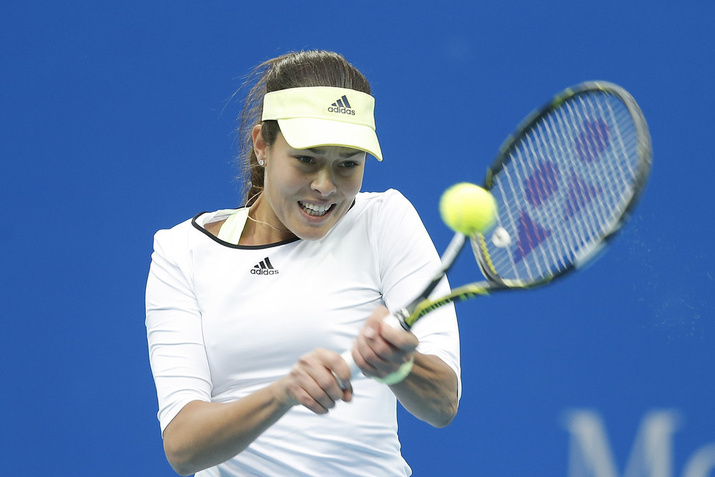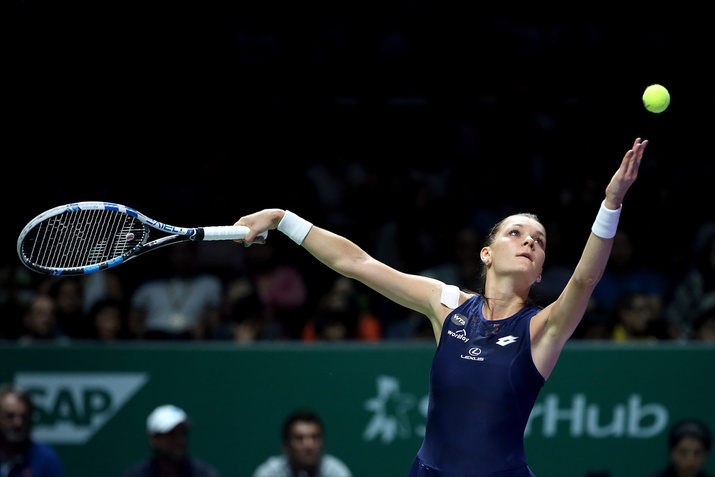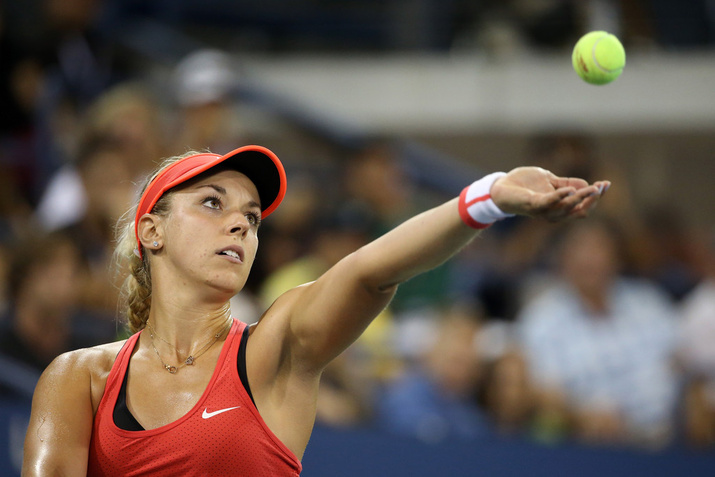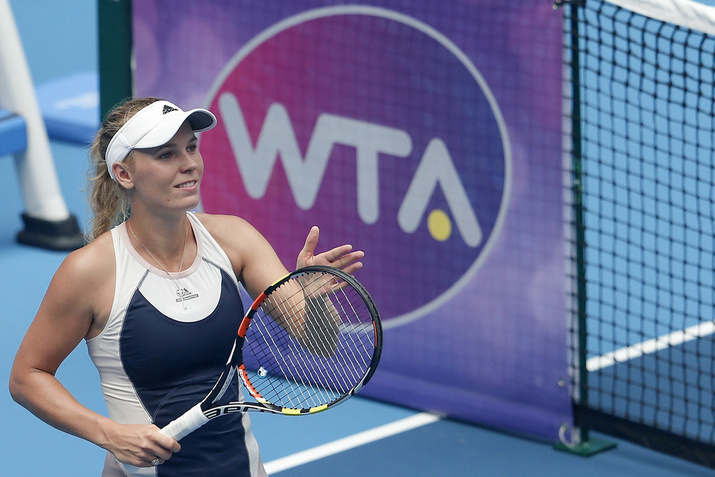Don't miss any stories → Follow Tennis View
FollowThe Curious Cases of Ivanovic, Radwanska, Lisicki, Wozniacki
Despite their talent, Ana Ivanovic, Agnieszka Radwanska, Caroline Wozniacki, and Sabine Lisicki have only won one Grand Slam title among them. But they could have won so much more, and while the presence of Serena Williams is undoubtedly a factor in their relative lack of success, it is far from the only reason why they haven’t won more of the biggest prizes in women’s tennis.
The key factors in their respective struggles neatly separate these four women into two categories – the shot-makers who lack mental strength – Ivanovic and Lisicki – and the mentally strong athletes who lack the ability to hit powerful winners – Radwanska and Wozniacki. If the abilities of one woman from each category were combined, the result would be an amazing tennis player. Thankfully for the rest of the WTA Tour, that is not possible.

It is no surprise that Ana Ivanovic won the French Open in 2008 at the age of 20. She arguably has the most potent range of shots of any player in women’s tennis, since she can hit anything from an unstoppable forehand to a drop shot played with vicious backspin. At her best, she is a superb returner and can serve extremely well too. Ivanovic is also capable of going on spectacular hot streaks during a match when she plays virtually unbeatable tennis and moves well around the court. In short, she has absolutely everything that a player could want from a physical point of view.
However, Ivanovic is often all over the place mentally. One match, she will be completely focused and will demolish her opponent. In the next, something will go wrong, she will get herself agitated about it, and the match will rapidly go downhill. All of this seems to happen because she expects such incredibly high standards of herself and, when she cannot match the expectations she has for herself, she gets down on herself up about it, and her play gets even worse. Ivanovic’s fans find her best tennis thrilling to watch, but too often she frustrates them by not achieving what she should.
When she won at Roland Garros in 2008, Ivanovic played stunning, fearless tennis throughout. That success also took her to No. 1 in the world, and life probably could not have gotten any better than that for the Serbian superstar. Given her personality, it has arguably hampered her since, as she tries so hard to recreate her early success. Perhaps if she had not peaked so early, Ivanovic would have lower expectations of herself as a player. This in turn would probably result in more consistent performances and possibly more Grand Slams. When Ivanovic retires, she will be delighted that she is a Grand Slam champion, but she is capable of winning more than she has and should already have done so with her immense talent.

Agnieszka Radwanska recently won the biggest title of her career: the WTA Tour Finals. She shed a few tears when she lifted the trophy, and it was obvious how much it meant to her. The success was a deserved reward for one of the hardest-working players on the women’s tour. In 2015, Radwanska was in the top five of matches played (76) and matches won (51). More importantly, the Pole’s success in Singapore could inspire her to win that elusive Grand Slam she so craves in 2016.
Her best chance will be at Wimbledon, since her stunningly inventive, energetic game is well-suited to grass courts. When Radwanska reached the final in 2012, she played well but was ultimately defeated in three sets by Serena. It remains the only time she has even taken a set off the American in a WTA Tour match, and it is clear from her 0-8 record against her that she finds her power very difficult to deal with. Given this, it is impossible not to conclude that her best opportunities to win a Grand Slam will arise when Serena is beaten by somebody else.
Radwanska wasted one such opportunity at Wimbledon in 2013, when she faced Serena’s conqueror Lisicki in a semifinal after the German had produced arguably the best performance of her career to beat the American in the fourth round. It was a brilliant last-four encounter, worthy of its own DVD, and its final stages should have brought out the very best in the mentally strong Radwanska. However, she failed to take her chances, and it was Lisicki who prevailed 9-7 in an epic final set.
Radwanska’s best performance at a Grand Slam other than Wimbledon came when she reached the semifinals at the Australian Open in 2014, courtesy of a stunning win over Victoria Azarenka in the quarterfinals, when she played sublime tennis to win 6-1 5-7 6-0. However, she was unable to maintain that high standard and lost in straight sets to Cibulkova in the last four. The Pole has also reached the quarterfinals in Melbourne on four other occasions, so it is probably her second-best chance for a Grand Slam behind Wimbledon.

Sabine Lisicki, Radwanska’s conqueror in that fateful SW19 semifinal, froze on the biggest occasion of her career two days after that win. A final on grass – her strongest surface – against flamboyant Frenchwoman Marion Bartoli was a superb chance to win a Grand Slam. But Lisicki seemed overwhelmed and played poorly to lose the first set 6-1. She rallied a bit in the second set but still lost it 6-4 and with it her best chance of winning a major title in her career.
It is difficult to imagine the German reaching such heights again. She is very talented and can belt winners past any opponent, including Serena, at will. She also has the most powerful serve on the WTA Tour and uses it to devastating effect when she is playing well. As recently as June 2015, Lisicki broke the world record for aces in a WTA match when she hit 27 in her 6-1 7-6 win over Belinda Bencic at the Aegon Classic. She also holds the world record for the fastest serve ever hit by a woman at 131 mph.
But for all her breathtaking power, Lisicki has never been consistent. Her tendency to be brilliant one day and hopeless the next is even more marked than that of Ivanovic, and sometimes she does not seem sufficiently motivated to produce her best tennis. That record-breaking week in Birmingham is a prime example. Lisicki was playing superb tennis and did not drop a set on her way to the semifinals. But, faced with a fighter in the shape of countrywoman Angelique Kerber in the last four, the German did not display any battling qualities as she surrendered meekly to a straight-sets defeat. She easily could have won the tournament.
Despite having a totally different game from Radwanska in every way, Lisicki’s best surface is undoubtedly grass. As with the Pole, the Grand Slam she is most likely to win is Wimbledon. However, she has similar attributes to Serena, and she has already shown she can match and even outplay the world No. 1 when she is at her best, so she should also be capable of challenging for a hard-court Grand Slam title. But is she motivated enough to try and achieve success in New York and Melbourne? We shall see.

Caroline Wozniacki is the least naturally talented of the four women in this group, but this does not mean she is any less capable of winning a Grand Slam. Wozniacki is probably the fittest woman on tour, as her time of three hours and 26 minutes for the 2014 New York Marathon aptly demonstrates, and she can therefore out-run and chase down more balls than any of her opponents. This typically means that only highly explosive players are able to beat her. Unfortunately for Wozniacki, there are plenty of those players on the tour – both Williams sisters, Maria Sharapova, Victoria Azarenka, and Madison Keys to name just a few – and this has proved the main barrier to the Dane’s success.
In 2010, the year she went to No. 1 in the world, Wozniacki lost in the Australian Open fourth round to Li Na, the Wimbledon fourth round to Petra Kvitova, the US Open semifinals to Vera Zvonareva, and the WTA Tour Championships final to Kim Clijsters. All these players have significantly more shot-making ability than Wozniacki and took full advantage of that fact in order to beat her. Despite such major losses, the Dane won 62 of her 79 matches that year – a superb record.
Losing to explosive players is a habit Wozniacki has never been able to break, and Serena has twice denied her notable titles in recent years. At the first time, the 2014 US Open semifinal, there was nothing Wozniacki could do, for Serena was at the top of her game in her straight-sets win. However, the Dane had no such excuse for losing the second time. She had Serena at her mercy when she had match points against her in the final set of their WTA Tour Championships semifinal. But she simply could not convert any of them, and Serena forced a tiebreak, saved yet more match points, and eventually won the breaker 8-6. If Wozniacki had been able to produce more opportunistically on any of her match points, she would have won the match and almost certainly the tournament. But that has always been her weakness and probably always will be, since no matter how hard she competes, she must be equipped to take her chances.
All four women have time on their side, with Ivanovic the oldest at 28 and Wozniacki the youngest at 25, so there is no reason why any of them cannot win one or more Grand Slams between now and the end of their careers. The only obstacles they face are their particular weaknesses, and they must believe they can overcome them, since this is the key to their future success.










